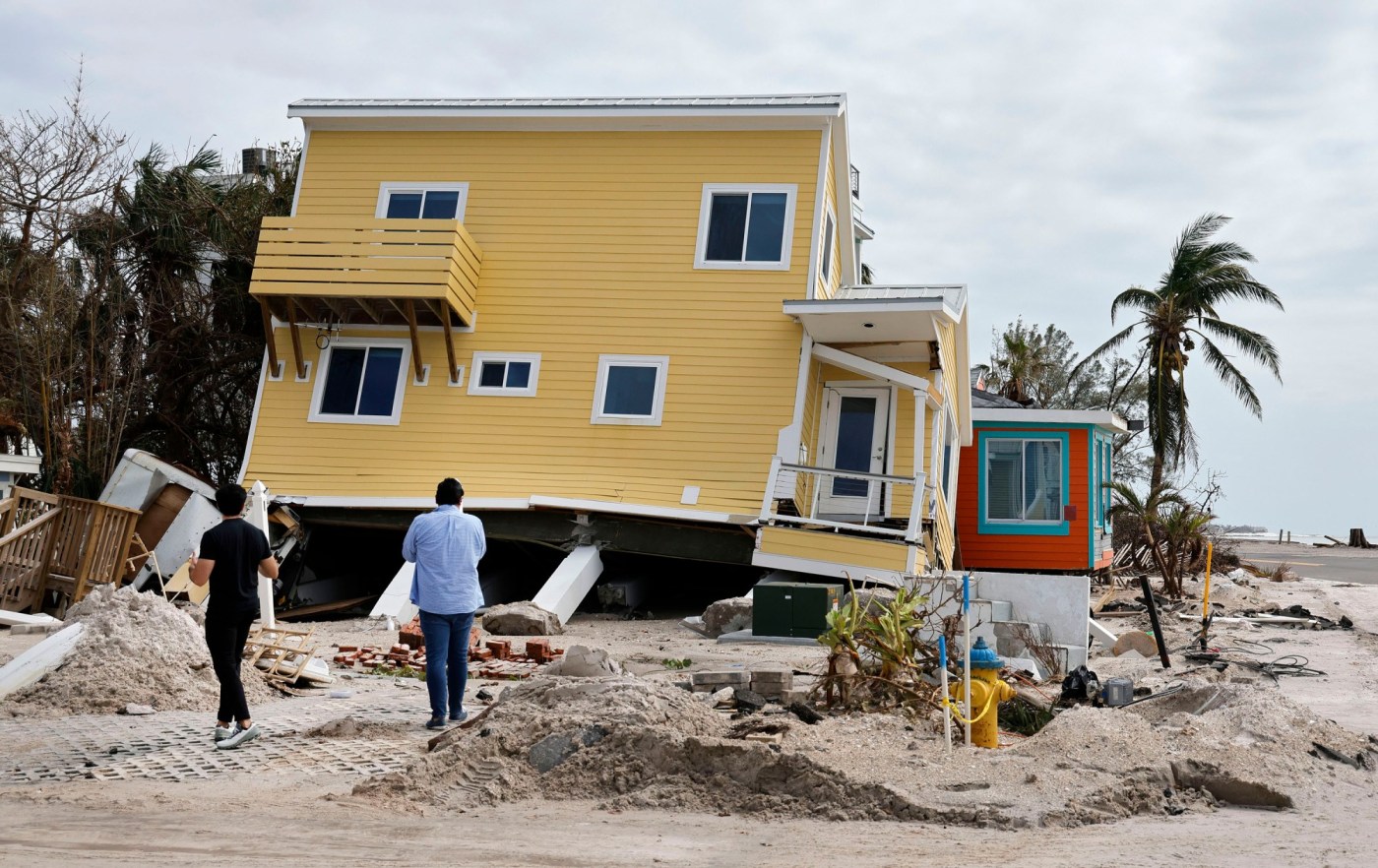
Extreme weather’s financial effect on homeownership
Hurricanes Helene and Milton are certainly making this another record-setting year for weather. But it’s not just headline-making storms giving homeowners reason to worry. California, Arizona, Maine, New Hampshire and Florida all had their warmest summers ever recorded, according to the National Oceanic and Atmospheric Administration (NOAA), registering long streaks of days over 100°F .
Such extreme heat strains infrastructure, crops and power grids — leading to outages that leave people without air conditioning in dangerously high temperatures. There’s also the risk of wildfires in many regions of the U.S., with droughts worsening the danger.
“The climate is changing, and science tells us it’s going to continue to do so,” says Janet Ruiz, director of strategic communications for the Insurance Information Institute. Yet many Americans say they haven’t done anything to prepare their homes or their finances against the increasingly likely damage of natural disasters and extreme weather events, according to Bankrate’s 2024 Extreme Weather Survey.
As a homeowner, it’s important to be aware of not just the physical toll, but the financial implications of extreme weather on your residence — and the steps you can take to prepare and minimize your out-of-pocket costs.
Key extreme weather statistics
In 2023, there were 28 weather disasters with damage that each exceeded $1 billion in the U.S.
Between 1980 and 2023, the U.S. had 376 weather and climate disasters with the overall damage costs reaching or exceeding $1 billion. The cumulative cost exceeded $2.7 trillion.
About $20 billion is being spent each year on repairing homes following major disasters and minor storms, according to Harvard University’s Joint Center for Housing Studies.
Americans spend an average of $1,667 on emergency repair costs per household, according to the 2023 State of Home Spending report from the home services site Angi. That’s up from $419 in 2019.
Financial implications of extreme weather
Weather events have caused more than $1.1 trillion in damage in the last 10 years, the most of any decade on record, according to NOAA. While some of those repair costs have been covered by insurance policies, property owners still have to pay their deductibles first. There are often other items they might not have expected, like several nights in a hotel if they are fleeing a hurricane or tornado, and that they’ll have to cover out-of-pocket.
Related Articles
Millions lose power every year because of extreme weather. Here’s how we could prevent it
Power shutoffs begin in Bay Area as winds rise, humidity falls
Bay Area winds to gain power; planned electrical shutdowns begin
Burning to learn: What research shows us about how to save a home
Here’s what the next two weeks of hurricane season look like in October
But Bankrate’s 2024 Extreme Weather Survey found that more than 1 in 4 (26%) U.S. homeowners say they are unprepared for the potential costs associated with extreme weather events in their area. And 43% have not taken any action to protect themselves against potential property damages from extreme weather events in the past five years — not even checking their insurance policies to see what is covered.
Among those who have taken precautions in the past five years to protect their property against extreme weather damage, 39% reviewed their homeowners or insurance policies to ensure they have proper coverage; 15% changed insurance carriers; and 13% increased their coverage or purchased additional coverage.
Extreme weather’s financial impact on your home
Extreme weather can have a range of ramifications for property owners, from immediate repairs to increasing maintenance to a gradual rise in energy and utility bills. As a homeowner, it’s important to understand the types of weather events that may hit the region where you live and, if possible, take steps to mitigate the fallout when possible. But as climate change makes extreme events more extreme, more and more regions are becoming vulnerable.
For example, Hurricane Helene likely caused $30.5 billion to $47.5 billion of property damage across 16 states, according to CoreLogic. That includes $20 billion and $30 billion in uninsured flood losses. In Florida, Hurricane Milton spawned tornadoes that wreaked havoc on the opposite coast from where the storm itself made landfall.
“The reality is that climate change presents a heightened threat to the financial well-being of (all) individuals and households, including homeowners,” says Mark Hamrick, Bankrate’s senior economic analyst.
Home insurance coverage and deductibles
With extreme weather events causing billions of dollars in damage, the cost of home insurance is soaring in many states as companies raise premiums to cover the rising (and increasingly likely) expense of rebuilding/repairing storm-damaged homes. In some cases, they are also limiting coverage while increasing deductibles — the amount the homeowner pays for an incident, before the coverage kicks in.
“Increasingly, private insurance carriers have been exiting markets where risk of natural disasters are seen as high. And where coverage has been available, the costs have been rising,” says Mark Hamrick, senior economic analyst for Bankrate.
This situation applies especially in states that are most severely impacted by extreme weather or natural disasters, like Florida, Louisiana, Texas and California. Across the United States, the average cost of homeowners insurance is $2,285 per year for $300,000 in dwelling coverage, based on October 2024 data. In Florida, the average is $5,527, in Texas it’s $3,916, and in California, where regulations cap the amount insurers can increase premiums, it’s $1,480.
While California sounds like a bargain, an increasing number of homeowners there are getting cancellation notices as major companies like Allstate announce they will exit the state or limit the issuance of new policies — the result of years of worsening wildfires.
Often, those homeowners then are forced to use the state’s FAIR Plan, which is more than twice as expensive as a standard policy and limits coverage to catastrophic loss. To get other coverage typically bundled into a home insurance policy, such as liability insurance, homeowners have to purchase add-ons, cafeteria-style.
Loss of property value from extreme weather
Another ramification of extreme weather for homeowners is the potential decline in property values. Of course, damaged homes can be repaired and sometimes even appreciate as a result. But in areas that are particularly hard hit by extreme weather events, the real estate market may start to decline — especially if homes sustain repeated damage, like those in the states affected by the one-two punch of hurricanes Helene and Milton in October. Reselling those homes may prove challenging.
In the worst-case scenario, if a once-expensive area tumbles drastically due to its “disaster-zone” rap, homeowners could end up underwater on their mortgages, unable to sell unless they come up with a bundle of cash to pay the difference between the home loan and the current property value.
In some cases, the Federal Emergency Management Agency (FEMA) provides grants to state and local governments to purchase homes that have been repeatedly damaged, so the building can be demolished and the land returned to open space. The idea is: The local community gets public land and federal taxpayers save money by not having to pay to repeatedly repair the property through the federally subsidized National Flood Insurance Program.
But it’s not a quick fix. The average time from a natural disaster to a FEMA-funded “floodplain buyout” is five years, according to the Congressional Research Service.
Property damage and repair costs
Just one inch of floodwater can cause up to $25,000 in damage, according to FEMA. Homes with basements, especially if critical utilities like furnaces and water heaters are elevated off the floor, would see less damage, FEMA says.
Floods once were a danger mainly to island or ocean-front properties or homes in river basins. No longer. “When intense storm surge and flooding events like Hurricane Helene reach regions that are infrequently affected by natural hazards, we can expect to see damage to homes without flood insurance coverage,” says Jon Schneyer, director of catastrophe response at CoreLogic.
As extreme weather events become more frequent, spending on home maintenance and repair projects will tick upward, according to a forecast from the Joint Center for Housing Studies. Homeowners will spend $466 billion on remodeling through the 12 months ended June 2025, the Joint Center estimates That would be an increase of 3.6% from the end of 2024.
There are three aspects to protecting your home from extreme weather events. The first is insurance coverage; the second, physical preparation; the third, financial readiness.
Insuring your home
The first step should be shopping around to see if you have the best homeowners insurance coverage. While you’re doing that, you can check to see if your policy covers the most common type of natural disasters that occur in your region of the country.
Most homeowners insurance policies don’t cover flooding caused by weather events. But, damage from a broken water heater or leaking dishwasher typically is covered, as long as deferred maintenance or other negligence wasn’t a factor.
The average flood insurance policy is $800, with the cost lessening for homes that are not in federally declared flood zones. According to the Insurance Information Institute, only 1% of homeowners who experienced record flooding from Hurricane Helene had flood insurance.
To get coverage for a natural flood, speak to an agent who offers flood insurance as a separate policy. While the federal government is the biggest flood insurance provider through its National Flood Insurance Program (NFIP), it doesn’t deal with the public directly. However, the NFIP website provides a search tool to find an agent.
Earthquake coverage is also a separate policy. Your current insurer may be able to add it at an additional charge — make sure to ask about deductibles and exclusions. You can also purchase it as a standalone policy. Call your state’s department of insurance to find a licensed provider.
Wildfire damage typically is covered by standard homeowner policies, but insurers in high-risk areas may exclude the coverage or set a separate deductible for wildfires. Check with your agent to find out.
Policies usually cover wildfire losses for both homes and personal belongings. They may even include garages and sheds under the “other structure coverage.” Also, coverage may include the cost of living elsewhere while your home is being rebuilt — check for your “loss of use” coverage.
Preparing your home
Emergency repair costs resulting from weather events can range from a few hundred dollars for minor damage to thousands of dollars for bigger projects.
As extreme weather becomes more common, it’s increasingly important for homeowners to prepare, with the goal of preventing costly damage, says the Insurance Information Institute’s Ruiz. “One way to mitigate risk is to build stronger homes and harden existing homes to help to withstand climate change,” she says.
If you start projects long before hurricane or wildfire seasons, contractors will be more available and more likely to offer you a better price. Make sure to get multiple bids, so you know you are getting the best deal.
If you’re doing it yourself, it will be easier to find what you need at the building supply store if you go before there’s a crush of frantic people who put their disaster prep off for too long.
Preparing for hurricanes
Install storm shutters — sometimes called hurricane shutters — to cover windows and skylights. In addition to preventing flying objects from penetrating your home and causing water damage.
If you don’t like the appearance of storm shutters, consider impact-resistant windows. But be prepared to pay more — perhaps more than triple the cost of hurricane shutters. And, while the windows are unlikely to shatter, a direct hit from a flying object could crack them.
If you live in an area of the country where hurricanes are a fact of life, make sure your roof is secured with hurricane straps. The straps are made of galvanized metal, and help to keep your roof attached to the walls of your house.
If you have any trees that could fall on your home, consider removing them or at least cutting them back. Also, when a storm is approaching, make sure to store or anchor patio furniture, trash cans, and barbecue grills to prevent them from becoming airborne. Make sure your neighbor does that too, so his grill doesn’t end up in your living room.
Preparing for a loss of electricity
Many types of extreme weather cause the loss of electricity. That’s when you will wish you had a generator. The easiest way to provide backup electricity is with a permanently installed one. You can power your whole house, or just key elements like your furnace, your kitchen and a few outlets in other rooms. No need to do anything — it will turn on automatically when a power loss occurs.
Before you invest thousands of dollars in a generator, make sure to compare different models, especially checking what they sound like when they are running. Some are quieter than others.
Lots of people have sump pumps to protect homes from rising groundwater. If you’re installing a generator, that’s one of the most important circuits to hook up.
Portable generators that are cheaper, but they require gasoline. Plus, you’ve got to drag them out when you need them and run extension cords to hook up the most important outlets.
Protecting your home from wildfires
If you live in regions where wildfires are a threat, the Federal Emergency Management Agency recommends creating at least 30 feet of “defensible space” around your home. That means removing flammable vegetation and replacing it with noncombustible materials such as gravel, brick, or concrete.
Your roof is the most at-risk part of your home during a wildfire because of wind-blown embers, FEMA says. If you can, replace shingles of wood or low-quality asphalt with metal, typically aluminum, coated steel, copper or zinc.
It’s a good idea to keep gutters clean, or use gutter guards that keep leaves and other potentially flammable debris from clogging them. Also, cover attic vents and under-eave vents with metal wire mesh no larger than 1/8 inch to keep embers out.
Financial preparedness
Along with conducting home maintenance and having appropriate levels of insurance, it’s also critical to be financially prepared for extreme weather.
One way is to have an emergency savings fund. For home maintenance (including unexpected repairs), one common rule of thumb recommends setting aside at least 1%, and as much as 4 %, of your home’s value each year.
“Financial preparedness raises the need to have sufficient emergency savings, which is something most Americans have kept on their to-do list,” says Hamrick. “These funds must be liquid, or easy to get to, because they might be needed quickly and without much, if any, warning.”
But with more Americans struggling to pay their grocery and energy bills following years of elevated inflation, that’s becoming harder to do. As of May 2024, over 1 in 4 (27%) Americans say they have no emergency savings to fall back on, and as of January 2024, 32% say they have less in their emergency savings fund than they did a year ago, according to Bankrate’s 2024 Emergency Savings Report.
If you can’t keep a lot of cash in reserve, Plan B is to have a ready way to get cash should the worst happen. To that end: Consider a home equity loan or a HELOC (home equity line of credit) to help fund emergency repairs or extreme-weather-related needs. Earmarked for large, five-figure expenses, both these instruments let you borrow against the value of your residence — letting you use your home to fix your home, in effect. With HELOCs in particular, you can draw on the funds only when you have a need — like sudden damage on your home — and then pay interest just on the money you’ve used.
Admittedly, they aren’t free: Average home equity loan and line of credit rates are in the 8% to 9% range. Still, that’s a lot cheaper than many personal loan and credit card rates.
For that reason, “A home equity loan or line of credit would come into play more if you have a major repair and it’s not covered by insurance,” says Ted Rossman, a senior industry analyst for Bankrate. Or if you expand the repair to make a major upgrade, improvement or addition to the home.
FAQ
What financial assistance programs are available for homeowners affected by natural disasters?
The Federal Emergency Management Agency (FEMA) provides financial assistance to affected individuals and households. However, don’t expect that aid to take the place of insurance. Unfortunately, the funds don’t come anywhere near the cost of rebuilding homes and replacing personal belongings, says the Insurance Information Institute’s Janet Ruiz.
Will my homeowner insurance cover all damage caused by a natural disaster?
Not necessarily. Flood-related damage is not typically covered by homeowners’ insurance: You need to purchase a separate flood policy. But insurance may cover other types of disasters including wind, hail, lightning strikes and wildfires. Talk to your insurance agent to see exactly what is covered and whether it’s for full replacement value (which accounts for inflation and appreciation).
How can I protect my financial records during a natural disaster?
It’s a good idea to collect vital documents and information, including numbers for bank accounts and insurance policies, and store them in a safe spot such as a fireproof or waterproof box. Even better, use a phone scanning app to capture documents and save them to your cloud storage, but remember that connectivity can be a challenge immediately after a natural disaster. It’s also a good idea to have some cash on hand in case electricity outages knock out your local ATMs or stores’ credit card scanners.
Visit Bankrate online at bankrate.com.
©2024 Bankrate.com. Distributed by Tribune Content Agency, LLC.


